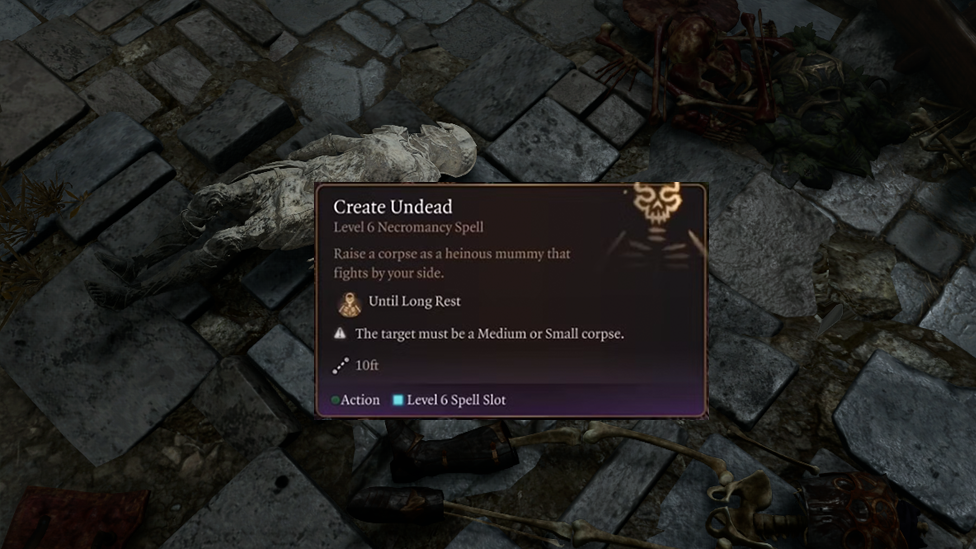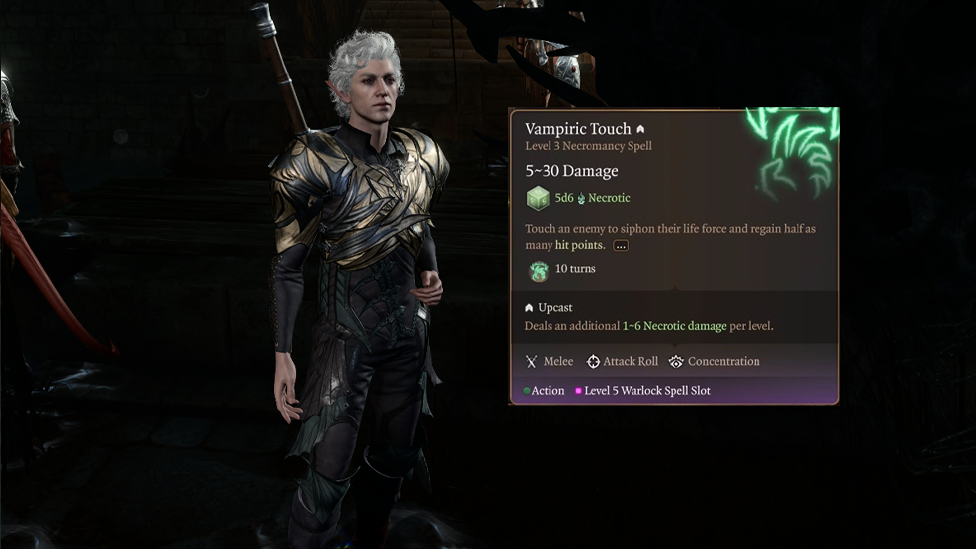Best Necromancy Spells in Baldurs Gate 3
Necromancy. The word alone is often enough to come with negative connotations and ideas; however, when it comes to Baldur’s Gate 3 Necromancy, there are actually numerous benefits associated with following this play style. As such, today, we’re looking at everything you should know about Baldurs Gate 3 Necromancy to help. Hopefully, this will allow you to make the most of your next game, too.
What is Baldur’s Gate 3 Necromancy?
Before we go any further, we ought to briefly define what Baldur’s Gate 3 Necromancy actually is. Necromancy is a specialized form of magic that allows the user to summon the dead - not a bad skill to have at all, and one that undoubtedly can be a powerful tool to rely upon, especially in group combat situations. Furthermore, Necromancy also opens up a range of other spells and abilities, making it well worth considering when creating a character.
The Best Baldurs Gate 3 Necromancy Spells You Should Know
With the properties of Necromancy in mind, it’s not worth thinking about the range of spells you can utilize. Of course, as a Necromancer, one of the biggest tools in your arsenal will be the ability to summon the dead to fight by your side in combat; however, this isn’t the only spell that Necromancers can utilize.
Following this thought, some of the best spells in Baldurs Gate 3 for Necromancers include the following.

How to Build a Baldur’s Gate Necromancy Character
Thus far, we’ve looked at a range of the very best spells available to those who choose to play Baldur’s Gate 3 as a Necromancer. However, before you start your game, there are several factors you may want to consider to prep your game properly. In many games, this will involve setting up a private server with a company such as ScalaCube to ensure heightened safety and stability; on a similar line, for Baldur’s Gate 3, proper character planning is paramount.
There are several things you might want to consider when building your Baldur’s Gate Necromancy player, and the following are generally the best options to choose:

Frequently Asked Questions
Final Thoughts
If you have been looking to optimize your next Baldur’s Gate 3 game, knowing about the different specialities and abilities is paramount. As part of this, speccing your characters to more accurately harness the power of Necromancy could prove a useful step. But remember: becoming a successful Necromancer in Baldur’s Gate 3 isn’t necessarily a two-minute process, and you’ll need to dedicate a lot of time to building up your army of the undead to ensure that you are able to face down any enemies with confidence.
What is Baldur’s Gate 3 Necromancy?
Before we go any further, we ought to briefly define what Baldur’s Gate 3 Necromancy actually is. Necromancy is a specialized form of magic that allows the user to summon the dead - not a bad skill to have at all, and one that undoubtedly can be a powerful tool to rely upon, especially in group combat situations. Furthermore, Necromancy also opens up a range of other spells and abilities, making it well worth considering when creating a character.The Best Baldurs Gate 3 Necromancy Spells You Should Know
With the properties of Necromancy in mind, it’s not worth thinking about the range of spells you can utilize. Of course, as a Necromancer, one of the biggest tools in your arsenal will be the ability to summon the dead to fight by your side in combat; however, this isn’t the only spell that Necromancers can utilize.Following this thought, some of the best spells in Baldurs Gate 3 for Necromancers include the following.

Make Your Own game Server
- Create Undead. We’d be remiss to start with any spell other than the Create Undead spell; after all, it’s one of the core focal points of the Baldurs Gate 3 Necromancers build. As such, it’s definitely a worthwhile spell. Notably, the spell also doesn’t require concentration and only needs a single action - and your undead ally will only expire on your next long sleep. As a result, creating an army to fight by your side is not only feasible but an incredibly valuable option.
- Animate Dead. Similar to the Create Undead spell, the Animate Dead spell also allows you to raise a skeleton to join your army, provided it’s a small or medium sized corpose. The spell also only needs one action and no concentration, and the benefit here is that you can create ranged allies to join your army.
- Inflict Wounds. This particular spell does what it says on the label: it causes any struck enemies with severe wounds equivalent to 3d10 of damage. Better yet, it only takes up a Level 1 slot, so you can keep your other spell slots open for even more powerful attacks.
- Harm. Going a step further than the basic Level 1 Inflict Wounds spell, Harm practically signs an enemy’s death warrant. This spell can often kill outright thanks to its 14d6 of necrotic damage; however, when this isn’t quite enough to wipe out a combattent, the target’s health is then permanently reduced, so they won’t be able to heal fully again.
- Blindness. If you’ve ever come across an enemy that just seems to be hitting far too hard and often, Blindness could be just the debilitating spell you need. This particular spell - as you likely will have guessed from the name - renders enemies blind, thus incurring a strong debuff on their combat rolls while also making them easier to hit (and reducing the chances of them hitting you). In total, Blindness also lasts for ten turns, which is plenty of time to gain the upper hand.
- Vampiric Touch. Being able to heal yourself during combat can often be incredibly useful. This is even better when that healing comes at the expense of your foe - which is exactly what the Vampiric Touch spell allows. With this powerful spell, causing three D6 of sleep, dread, or sickness damage, the player also heals for half of the damage. What’s more, it’s not a one off; you can keep recasting the spell after first getting a hit with no further damage being dealt.

How to Build a Baldur’s Gate Necromancy Character
Thus far, we’ve looked at a range of the very best spells available to those who choose to play Baldur’s Gate 3 as a Necromancer. However, before you start your game, there are several factors you may want to consider to prep your game properly. In many games, this will involve setting up a private server with a company such as ScalaCube to ensure heightened safety and stability; on a similar line, for Baldur’s Gate 3, proper character planning is paramount.There are several things you might want to consider when building your Baldur’s Gate Necromancy player, and the following are generally the best options to choose:
- Race: High Elf or Wood Elf
- Cantrips: Fire Bolt, Ray of Frost, and Acid Splash
- Background: Sage, Urchin, or Acolyte
- Abilities: High Dexterity, Constitution and Intelligence
- Skills: Any that complement your chosen background

Frequently Asked Questions
What are the benefits of Necromancer builds in Baldur’s Gate 3?
Necromancer builds in Baldur’s Gate 3 are excellent in situations where you want to increase the damage done by your attacks, with Necromancy spells often causing status effects on enemies. In addition, Necromancers can also summon the dead to create their own undead army.
What level of Necromancy allows me to unlock undead armies in Baldur’s Gate 3?
Once you reach Level 5 of Necromancy, you’ll be able to learn the Raise Dead spell. At Level 6, you can then learn the Animate Dead spell, further allowing you to create your undead army!
Final Thoughts
If you have been looking to optimize your next Baldur’s Gate 3 game, knowing about the different specialities and abilities is paramount. As part of this, speccing your characters to more accurately harness the power of Necromancy could prove a useful step. But remember: becoming a successful Necromancer in Baldur’s Gate 3 isn’t necessarily a two-minute process, and you’ll need to dedicate a lot of time to building up your army of the undead to ensure that you are able to face down any enemies with confidence.
Make Your Own game Server
Copyright 2019-2025 © ScalaCube - All Rights Reserved.